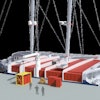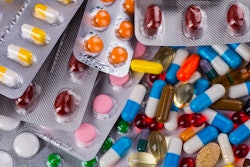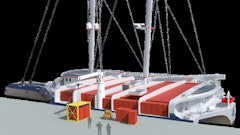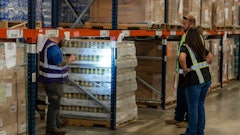
The intricacies of the pharmaceutical supply chain may not have been in the mainstream news a few years ago, but recent events kicked this subject to front page news. In 2019, Turing Pharmaceuticals CEO Martin Shkreli was exposed for price gauging lifesaving drugs, thus beaming a spotlight on the pharma supply chain, as Americans became wary of the price of their medications.
In 2020, the Coronavirus disease (COVID-19) ravaged the world and brought pharma’s supply chain into the forefront yet again, likely to remain there forever. These major incidents will leave lasting impressions on the sector.
“Prior to COVID, the pharma supply chain wasn't really exposed to the non-logistics/pharma world,” says Chris Orban, VP of data science at Trimble Transportation. “Drugs were produced, got to their final destination and distributed. A major product launch was still a big deal, and carriers had protocols and security requirements to follow, but it didn't receive the sort of scrutiny that has appeared during COVID-19. As with many other areas of our world, COVID-19 has shown both the vulnerability of our way of life, and the power of our supply chain to succeed and deliver when it could have failed.”
Pharma supply chain globalizes
One major trend that existed before the pandemic was the globalization of raw materials. Susan Beardslee, freight transportation and logistics principal analyst at ABI Research explains that much of the pharma supply chain relied on raw materials from China. Even before Coronavirus (COVID-19) this caused room for a wide range of supply risks.
Meanwhile, Christina Smolke, CEO of Antheia, adds that globalization in pharma is reaches even farther than that.
“Over the past two decades, pharma supply chains have steadily become more globalized,” she says. “Various steps of the drug manufacturing and distribution process occur in different parts of the world, for example, a medicinal crop might be farmed and harvested in Australia, processed in India, combined with other ingredients to form a final drug at a plant in Germany and distributed to hospitals or pharmacies in the United States.
“When functioning properly, globalized supply chains broaden access to critical medicines and create more favorable price points for important drugs. They have also led to stronger medical infrastructure across much of the world. However, the shift toward global supply chains has also created dependencies on foreign suppliers, which can sometimes cause problems for countries during times of drug shortages. This is what happened in the U.S., which now relies heavily on foreign suppliers for the active ingredients in many of its most essential medicines (80% of API manufacturers are outside the U.S)," adds Smolke.
 Antheia
Antheia
Along with globalization grew a focus on just-in-time (JIT) inventory to drive down costs. The JIT inventory strategy focuses on pairing raw material sourcing directly with production schedules, eliminating excess source product. Jennifer Biscelgie, CEO and founder of Interos, explains that while this approach was successful in driving down costs, it is prone to failure if there is any type of disruption. Additional, global trade offer significant instability as well.
Serialization also became rampant in the days before COVID-19 to drive safety in medications and combat counterfeiting, Biscelgie continues.
“Technology to monitor the integrity of the cold chain to ensure temperature ranges were maintained in shipping (to help guarantee drug efficacy) was gaining investment and is now critical with the vaccine,” she says. “Data traceability also was a high priority as the pharma supply chain worked to move data online so that the entire chain could see the data they needed to make fast and better decisions. The pandemic has greatly accelerated the digitization imperative and is also driving a strong trend toward supply chain risk monitoring and management, all toward the goal of operational resilience.”
Additional outside factors disrupted the pharma supply chain as well.
“Before the pandemic, supply chains were experiencing disruption as a result of several macroeconomic trends, including declining productivity growth, rapid digital economic expansion and increasing slowbalization (the slowdown in globalization due to trade wars and nationalistic tendencies),” says Baber Farooq, senior vice president of product strategy at SAP Procurement Solutions. “Since the onset of COVID-19, we’ve seen an increased focus on nearshore manufacturing across many industries. Simultaneously, we’re seeing digitalization allow for more cross-border services. Investment in digital transformation and automation have become only more important and immediate as companies re-evaluate their supply chain solvency.”
COVID-19 also heightened focus on pricing policing.
“Prior to the pandemic, the industry faced immense pressure to police its own pricing irregularities and link its business results to public health,” says Tinglong Dai, associate professor at Johns Hopkins Carey Business School. “In addition, personalized medicine was a major trend that drove much of the energy. There was also some pressure to increasingly adopt AI and data analytics.”
Another aspect of the industry that the pharmaceutical companies could not gain a hold of was consumer demand prediction, even before the pandemic struck. Chris Hale, CEO of Kountable, points out that while it might seem strange for a sector rooted in daily medications and prescriptions to have issues with demand planning, this problem perplexed care providers and manufacturers.
“A surprising number of patients don’t follow those prescriptions at all, don’t re-fill them according to plan or don’t take them according to their personal programs,” Hale explains. “These factors add noise to the demand signals that flow up the supply chain and send false signals to manufacturers and distributors alike, impacting their ability to accurately forecast throughout the supply chain and distribution. Understanding patient behaviors was considered an impossible dream, but newly integrated platform technologies are making this more achievable.”
Technology trends skyrocket
Like other industries in the supply chain, the trends in the pharma supply chain push technology innovation and adoption. When it comes to pharmaceuticals, tracking reigns supreme like much of the supply chain, and the COVID-19 crisis only makes it more prominent.
“Our industry has many tools for tracking and monitoring freight, from the standard onboard computers reporting the location, direction of travel and hours of service status of the truck and driver to more complex temperature monitoring systems that have risen to prominence during this crisis,” Orban says. “It is no longer a load of apples or ice cream that has to be carefully temperature-controlled; now an incredibly important shipment of vaccine could be endangered if the cooling systems in the trailer fail or the temperature rises without appropriate intervention.
“At the start of the COVID-19 vaccine distribution, escorts were required for many of the vaccine loads,” he continues. “This, while common for some types of high-value loads, was something that always adds additional stress for the driver and the carrier. The amount of responsibility we put on our drivers has only increased -- not only do they have to be away from home during a global pandemic, but now they might not be able to stop at their preferred truck stop due to security concerns or could have to change their sleep or eating patterns to make sure that we get the vaccine we so desperately need. The carriers themselves have to be equipped to brief the drivers, as well as make sure that security protocols are being followed, and this adds another layer to the complexities of moving freight through the country.
“If a fleet doesn't have an existing security program or high-value load process, it is possible they won't even be able to haul these loads, even if they have the proper equipment,” Orban adds.
Beardslee seconded that technology in transportation is vital. She emphasizes that cold chain trailers, box trucks, containers, air cargo and on-site freezers are important in not just transporting vaccines, but also in moving all temperature-controlled pharmaceuticals safely. Additionally, temperature monitoring technology and tracking software embedded into transportation management systems (TMS) are important for the growing need for visibility that has proved important in vaccine distribution. ABI Research
ABI Research
Specifically, for the vaccine, there are platforms that integrate CDC vaccine registration requirements.
But, it is not just transportation technology that is important in the supply chain.
“Many pharma companies are taking advantage of digital technologies, including cloud, robotic process automation and Internet of Things,” says Stephen Meyer, senior research director, Gartner Supply Chain Practice. “This can be leveraged for ‘smart’ products that result in better prescription adherence and more accurate dosing, as well as for new supply chain capabilities, like real-time shipment tracking that ensures products are delivered on-time and at the correct conditions. Analytical technologies that help derive insight from large and diverse data sets are also popular, like AI and cognitive computing.”
Farooq supports the argument for the need of automation, as it helps eliminates repetitive tasks, shifts focus to actual business outcomes and allows individuals to lean into aspects of the job that require human ingenuity.
“We can expect this trend toward the digital economy to continue and further accelerate,” he says. “Procurement has a clear role in supporting that transformation and the incorporation of intelligent technologies such as AI, machine learning and IoT into our daily lives.”
Gisli Herjolfsson, co-founder and CEO of Controlant, emphasizes the importance of other technology such as enterprise resource planning (ERP) systems, quality management systems, asset management, business analytics (BI) dashboards and blockchain platforms.
“Each stakeholder most likely uses something different to track and monitor their piece of the cold chain,” he says. “Companies are achieving greater supply chain and value chain orchestration by using a comprehensive control tower that unites these disparate systems and organizations. Having a fully connected and integrated control tower provides all parties, across business, manufacturing, operations, and supply chain functions, with a single source of truth.”
In addition to comprehensive control towers, cloud software can help.
“Cloud software platforms can serve as the backbone of the information supply chain so that all supply chain participants are on the same page and to provide a clear record of product custody as it moves through the global supply chain,” Bisceglie says.
“In mapping, monitoring and modeling supply chain risk, AI-based technology can serve as an early-warning system. AI- and machine learning-based platforms can quickly and effectively map the global supply chain to the nth tier (not just Tier 1 suppliers) and then deliver continuous monitoring against dozens of supplier risk factors. Previously, this monitoring was done annually and manually -- processes that were highly inefficient and left massive blind spots that heavily impacted brands during the pandemic, before it, and still do.”
But, technology is not only important in the movement of pharmaceuticals, but also in the sourcing from nature.
“Nearly half of pharmaceuticals are sourced from nature, mostly plants,” says Smolke. “While the technology required to transform these natural materials into medicines varies considerably, plant-based drugs are generally manufactured through a multi-step process that begins on specialized farms, where the medicinal crops are farmed and harvested. Once these plants arrive at processing facilities, they undergo extensive physical and chemical treatment to extract and isolate their medically relevant components. Once isolated, these components are combined with other raw materials or further modified through chemical reactions to become active pharmaceutical ingredients (APIs), the base of all drugs.
“New technologies are offering a better way to produce highly complex medicinal molecules on demand. With today’s current understanding of DNA and modern computational tools, scientists can bioengineer the ingredients for medicines using plants as inspiration, not raw supplies,” adds Smolke
“To do this, scientists identify the genetic code that produces beneficial molecules in plants. They replicate those molecules by inserting synthetic DNA into brewer’s yeast, then grow the engineered yeast in large fermenters. In just two weeks, this process can yield highly valuable molecules at commercial scale,” she says.
What can go wrong?
While technologies solve many problems throughout the pharmaceutical supply chain, companies involved in the industry have numerous pitfalls that are vital to pay attention to, the most important being temperature control. Technology, of course, has a place here as well.
“Temperature control for many vaccines can go out of spec as too cold or too hot,” says Beardslee. “Like fresh and frozen foods, there are expirations that need to be considered for inventory. End-to-end visibility and condition tracking are important to avoid loss, tampering, delays. Do not forget reverse logistics – any special monitoring devices, containers and potentially PPE and medical waste require a plan. Future mRNA vaccines for cancer, flu, HIV need investment in ultra-cold freezers.”
These temperature-control issues are such an important factor, not just for the health of patients, but also for the bottom line of the pharma supply chain.
“The biopharma industry loses approximately $35 billion annually due to failures in temperature-controlled logistics,” says Herjolfsson. “Within the cold chain, problems typically happen at multiple handoff points. Today, temperature excursions account for nearly 80% of supply chain problems, damaging products and diminishing consumer confidence in the brands they once trusted. Each lane of travel—air, road or sea—requires different handoff points and poses different risks. Losses of temperature-controlled products often occur because cold chains have historically lacked real-time access to actionable data that enables accurate decision-making and documents the integrity of delivered cargo.
“The nature of data collection compounds this problem for temperature-sensitive and perishable products,” Herjolfsson adds. “Many siloed points along the supply chain lack connectivity. Data collected by condition-monitoring devices is not always immediately available for review and analysis to assess and ensure products’ quality and safety at the end of the supply chain. The lack of visibility has limited businesses to decision-making based on collecting data only at the endpoints of the product journey, and often only after degradation or waste has occurred.”
Having a siloed system can make it challenging to compose data-driven decisions.
“Only by connecting the supply chain from end to end will organizations have the information readily on-hand to move from reacting to problems after the fact, to be able to prevent issues, and finally, to be able to predict what might occur,” Herjolfsson continues. “Many companies have access to descriptive analytics showing what has happened after the fact. However, having prescriptive and predictive data allows organizations to see what will occur and provide them with ‘what-if’ scenarios allowing them to make the best decisions.”
Before the transportation process even occurs, pharmaceutical companies also have a disadvantage to other sectors in the supply chain as quality control is more intricate because these products directly relate to the health and lives of the consumer.
“Pharma supply chains are ultimately defined by the products they support,” Meyer says. “Given that the products are used to improve health and save lives, product safety and efficacy are paramount. This can make coveted capabilities like agility and just-in-time difficult, if not impossible, to implement because they can introduce additional risk to the supply chain. Other pitfalls include lack of visibility in the overall healthcare supply chain (all the way to the patient), the fragmented nature of healthcare regulations around the world and the lack of supply redundancy (both suppliers and internal manufacturing).”
Moving even further into the process, the pharma supply chain only becomes more delicate.
“The supply chain for drugs sourced from plants is highly fragile,” Smolke says. “Most active pharmaceutical compounds are extracted from plants that are farmed as crops, an inefficient, expensive, risk-laden process. Agricultural supply chains are vulnerable to natural disasters, climate change, pests and disease; they’re also inflexible to sudden changes in demand. The consequences, which include shortages of life-saving drugs, can be deadly.”
“The pursuit of profitability without accounting for human consequences will inevitably backfire,” says Dai. “The opioid crisis is an obvious example.”
Additionally, the pitfalls remain after the transportation process as well, as shelf life becomes a factor.
“Some of the most obvious pitfalls are related to inventory management, provenance of the drugs and shelf life,” Hale says. “All three are related and a potential source of major risk to patients and inflation of costs of delivery. In supply chain, there is a common phrase called OTIF. This is a standard for many of the major global brands like Walmart that have made supply chain their business and it stands for ‘on-time, in-full’ delivery.
“Said more simply, did all of the right stuff show up at the right place at the right time? As pharmaceuticals move from the point of manufacturing through a distributed delivery network to the point of patient care, tracking these cascading versions of OTIF become more difficult and are complicated by issues related to recall, expiration and inventory management. Healthcare has demonstrated the need to build backwards from the point of care and ensure strength throughout the system,,” adds Hale.
While technology becomes a savior for many pitfalls, it also brings up a new area of concern -- cybersecurity.
“Supply chains are also becoming the new cybersecurity battleground,” says Bisceglie. “CIOs, CISOs and chief procurement officers must work together in a new type of collaboration to protect an organization’s security and operational resilience, in the face of now frequent cyber-attacks from nation states and bad actors on the supply chain. In fact, a recent study found that a shocking 80% of respondents had suffered a breach via their supply chain in the past 12 months, with 47% suffering 2-5 breaches. Supply chain leaders must be able to monitor the cyber hygiene of its business partners in near real-time.”
Vaccine rollout is far reaching
All of these issues remain even if there were not a global pandemic, but with COVID-19, the pharma supply chain becomes even more stressed. Now what does this mean with multiple vaccines and a rush to get them to the public?
Orban stresses that everything is connected and saw this first-hand during the Moderna vaccine trial.
“I participated in Moderna’s Phase III vaccine trial, and while I was initially part of the placebo group, I was offered the opportunity to receive the actual vaccine following the trial for additional monitoring, which I accepted,” he explains. “While I was at the clinical trial site for my second dose, I was speaking to the study coordinator, who shared that although they have what he described as ‘a secure pipeline’ to the Moderna vaccine for the clinical trial, what he doesn't have enough of are syringes, bandages and alcohol swabs to actually administer the vaccine.
“As I was sitting in the waiting room, a UPS driver arrived with what turned out to be just enough supplies to vaccinate the trial participants who were there that day,” he adds. “Again, the vaccine was not the issue; it was all the other supplies that don't get the escorted loads or the high-priority treatment and that every other vaccination and medical facility also needs. Bandages aren't just used after you get a vaccine shot, of course, other stores like Walgreens and CVS need them in stock for people who get scrapes and cuts.
“I hadn't even considered this aspect of the COVID-19 vaccination process, and it reminded me that if we focus too much on any one aspect of the supply chain, we miss potential weaknesses in other areas,” Orban says. “Every single piece of the connected supply chain has to work together, at the right time, at the right pace, to make sure that all of the needed items arrive so we can get through this crisis.”
While supplies in the vaccine rollout can be lopsided, there is also lopsidedness in resource allocation, as the entire world focuses on COVID-19-related items. However, this could be a good thing for non-reefer carriers.
“Any time you spend resources on one area, you don't have them in another area,” Orban continues. “We likely don't even know the impact of dedicating so much of our capacity to one area of the supply chain right now. It certainly will create opportunities for carriers that might not be able to play a part in COVID-19 vaccine distribution, but perhaps could pick up loads that a carrier that is hauling COVID-19 vaccine can no longer haul due to capacity constraints.
“And, as with all other times when capacity is tight, we are reminded that we desperately need more trained, qualified drivers to haul our freight,” he says. “One thing that many fleets I've talked to have mentioned is that schools training new drivers are still nowhere near capacity. It certainly is difficult to remotely train someone to drive a heavy truck. So, with in-person learning difficult and our industry already facing a driver shortage, we have removed a large percentage of new drivers' ability to enter the workforce.
“Further, many people who might choose to become drivers in the past are now considering whether they want to risk catching COVID while away from family, or perhaps risk their family catching COVID while they are away. These are the same issues that have been a concern for a long time in our industry, just magnified in the present time,” Orban says.
Flexibility and visibility is critical to fight against bottlenecking.
"Flexibility to source new suppliers, inventory holding locations and freight forwarders, and agility in making critical decisions with accurate, transparent data-sharing will be vital," says David Kopstein, VP of life sciences & healthcare at DHL Supply Chain. "Visibility is about knowing your network and supply base, locating bottlenecks, and having real-time information about where your products are. The silos that exist across warehousing, packaging and transportation operations in many supply chains reduce agility, create inefficiencies and complicate visibility. We are seeing more organizations taking steps to increase integration across these critical operations and leverage end-to-end visibility tools, such as DHL’s MySupplyChain, to ensure continuity of supply, production, distribution, transportation and reverse logistics."
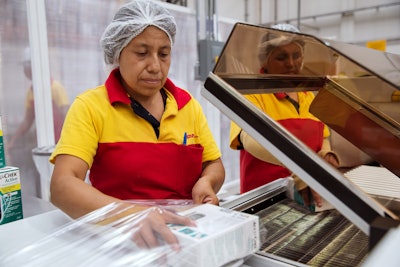 DHL
DHL
However, the bottlenecking hasn’t been as common as expected.
“As of February 2021, the ‘knock on’ effect has thankfully been minimal – the logistics bottlenecks that were feared haven’t materialized,” Meyer says. “This is in part due to the gradual approval and roll out of the vaccines. As we progress through 2021, supplies may tighten for key products and materials used in the broader manufacturing, packaging, transport and dosing of the vaccines – glass vials, syringes, dry ice, etc. The big ‘unknown’ is whether or not governments will use legislation/executive orders like the U.S. Defense Production Act to compel other manufacturers to support vaccine production or fill/finish.”
“The vaccine rollout has had three major impacts on the pharma supply chain,” Hale says. “First, everything COVID-related gets to go first. This disrupts existing supply chains and causes priorities to dramatically shift. This triage approach helps accelerate our response but can have adverse consequences to the supply chains serving other global epidemics like HIV, TB and Malaria. The focus, though, means that there is meaningful funding going into solutions that otherwise may not have been supported historically.
“Second, things are being fast-tracked at a pace never seen in modern supply chains. Much like the creation and approval of the vaccines, innovations in distributions are being piloted, funded and adopted at a breakneck pace and ‘digital-first’ is the New Normal,” he says. “Lastly, health equity has become a major focus in supply chains and distribution. COVID doesn’t discriminate, and in order to mount an effective response and prevent mutations that can occur as the virus has a longer and longer genetic history, we need to solve for the last mile. The urgency around that idea will have lasting effects on global health.”
While the transportation is affected, so is sourcing.
“It’s greatly straining the availability of raw materials and distribution mechanisms of other pharma supply chains,” says Bisceglie. “Cold chain capacity is being tested like never before, and suppliers are being overwhelmed by vaccine requirements for raw materials, vials, dry ice and specialized packaging. These materials will be prioritized for the vaccine, leaving other pharma producers scrambling for materials and transportation capacity.
“These factors make mapping, monitoring and managing supply chain risk before disruption occurs more critical than ever for all pharma brands. Brands must be nimble and quickly find new, reliable suppliers, continuously monitoring their ability to deliver,” Bisceglie adds.
COVID-19 changes pharma forever
The experience of COVID-19’s impact and the roll out of the vaccine will have an impact on the supply chain and the pharmaceutical industry forever.
“It has confirmed some strengths of the supply chain, namely resiliency – most supply chains were able to withstand the disruptions and not miss patient doses,” Meyer says. “In many cases, this was due to the deliberate and methodical approach to supply chain, and the heavy reliance on inventory as a buffer between supply and demand. But, the pandemic also highlighted weaknesses in the supply chain, like the fragile nature of global supply and distribution networks, the lack of visibility upstream (beyond Tier 1 suppliers) and downstream (to the patient), as well as the reliance on manual (human) processes. We will see investments to address the weaknesses in the coming years in the form of better visibility tools and multi-factor network planning.”
These weaknesses need to be addressed for the future, no matter the cost.
“We need to make sure that we have redundancy built into our supply chain,” Orban says. “This can be expensive, but we need to understand how, if the need arises in the future, we can deliver 600 million doses of a vaccine (or really any critically-needed supply – for example, as I’m writing this, Texas is facing food shortages due to extreme weather), in a short period of time. Although there is a difference between a hurricane or winter weather and a year-plus-long pandemic, the same thinking can apply, What failed before? How can we do better in the future?”
“I also think that COVID has brought attention to an aspect of our society, the connected supply chain, that for many people ‘just works,’” he says. “Before I joined the transportation industry, I barely even realized how many trucks there were on the road. Now, I am struck by the fact that every truck out there is driven by someone who is putting our needs ahead of their own to haul food, or my Amazon order, or in this case, the vaccine that will get us through this pandemic, and I am able to work from home while they take all the risk. It is humbling, and something that we should make sure is acknowledged.
“That grocery store isn't stocked magically, that sweatshirt didn't just appear, and the vaccine isn't available because someone says it is; drivers and carriers are doing the work, accepting the stress and risk and helping to keep us all fed, warm and safe.”
Throughout the rollout, demand in the medical field will need to be managed.
"Since the outbreak of the pandemic, demand for medical supplies has surged. For example, UNICEF sourced 100 times more face masks and 2,000 times more medical gloves than in 2019," Kopstein says. "Bringing medical supplies from their distant sources to use at the frontline has been one of the most crucial activities in pandemic response management in the first phase of the health emergency. For PPE specifically, inbound logistics were a major challenge due to geographically concentrated production, limited airfreight capacity and a lack of inbound quality checks. To ensure stable medical supply in a future health crisis, a comprehensive setup of public health crisis strategies and structures needs to be established by governments with partnerships from both public and private sectors.
"True, all eyes will be on the vaccine distribution effort in 2021, but this focus risks distracting us from another major challenge the sector will face in 2021," he says. "As more and more people return to elective surgery and we see a release of pent-up demand for other medical treatments, there will be pressure on pharmaceutical and healthcare companies to manage the surges in inventory across North America. The “bull whip” will require close monitoring and planning of inventory levels, efficient warehousing processes and additional strains on last-mile capacity."
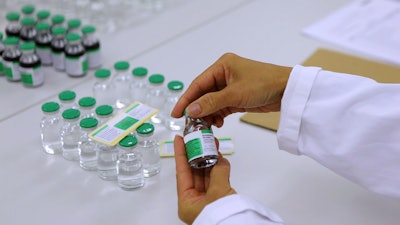 DHL
DHL
The need for collaboration has always existed in the supply chain, but its now so obvious it cannot be ignored. Companies coming together to solve the problem of a global pandemic shows the need for continued collaboration into the future.
“The pandemic has also proven the need for greater collaboration among all stakeholders within the supply chain,” says Herjolfsson. “Manufacturers, 3PLs, carriers, distribution centers, healthcare facilities and governments have all aligned on one shared goal -- to safely manufacture, distribute and provide vaccines to the world. Technology plays a massive role in connecting these disparate entities through sharing data. Doing so helps strengthen supply chain responsiveness and resilience while leading to better patient outcomes.
“However, monitoring these millions, and soon to be billions, of vaccine doses would have been costly and wasteful if the real-time visibility did not exist. Without real-time technology, the vaccine manufacturers would have experienced much higher excursion rates, resulting in product loss,. Even more importantly, the lack of visibility and manual efforts would have slowed down the vaccine shipments, which needed to get to patients quickly. Having this level of detailed data and preventive analytics made it possible for vaccine manufacturers to gain insights into supply chain operations, see where problems were arising, work with parties to correct those issues and create action plans to prevent them from happening in the future.”
Technological advances, growth in the supply and the ability to come together will likely remain as long as the pharma supply chain remains. However, it goes without saying new areas, trends and technologies will arise.




